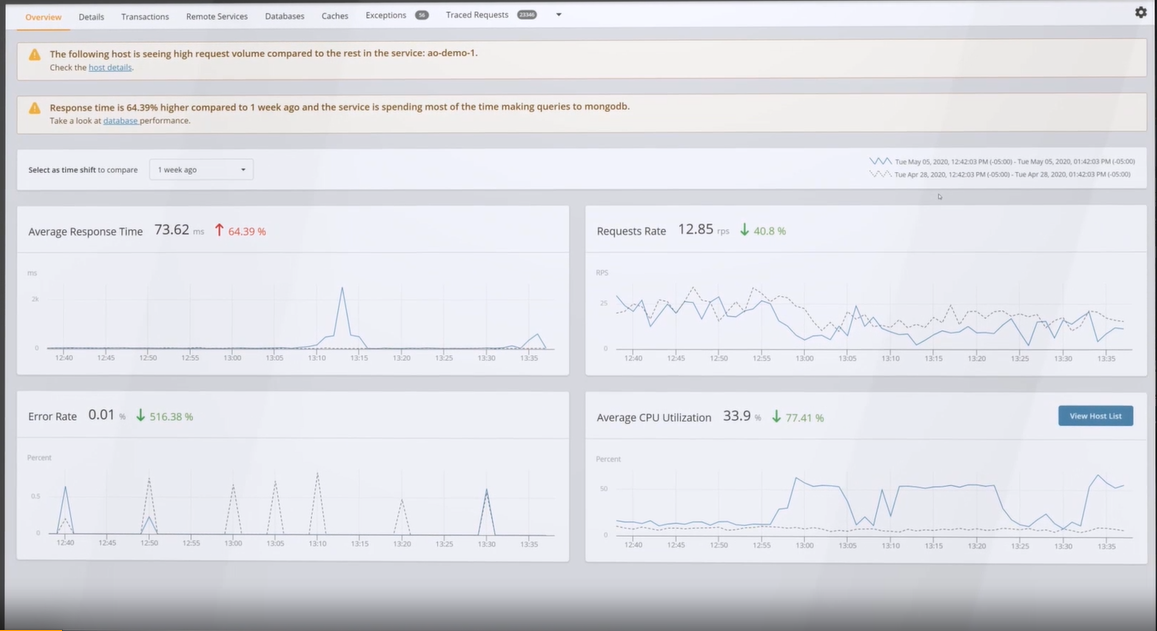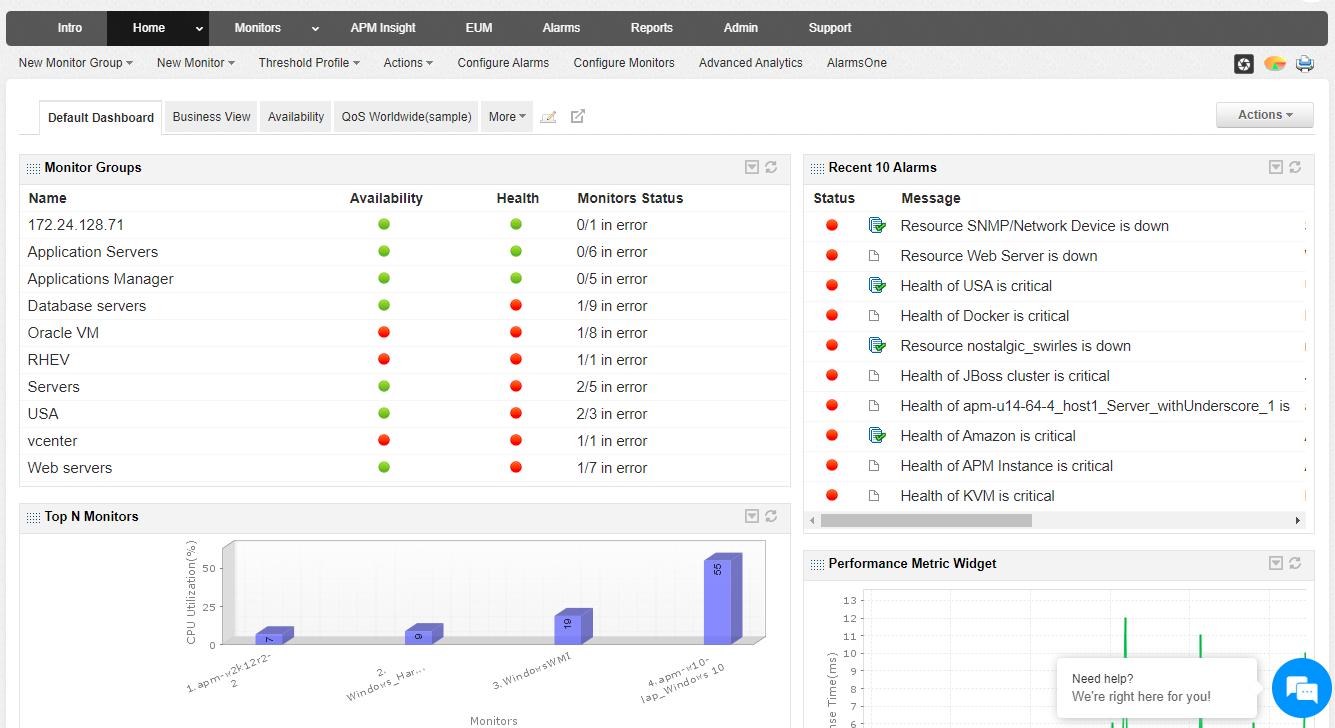With more and more companies embracing digital business models, business-critical applications become a key channel to reach out to customers. Customers expect seamless experiences with these applications and anticipate business to fix performance issues on the fly. Moreover, IT environments hosting and running business applications are more complex than ever, with a range of infrastructure, applications, containers, microservices, databases, and middleware components.
Application performance management (APM), also known as application performance monitoring, helps you monitor applications and optimize their performance by identifying bugs, latency in database queries, exceptions, and more. APM solutions also perform code profiling to help you understand which methods and functions are slow in an application. When an exception or error occurs, the APM solution does root cause analysis and generates a trace of the issue. In general, APM solutions also provide infrastructure monitoring capabilities, so IT teams can be made aware of application performance roadblocks in the underlying infrastructure.
How Does an APM Solution Work?
An APM solution monitors everything in your IT environment, including servers, applications, middleware, containers, and microservices. The solution works with agent-based monitoring, where an agent is installed on a host machine to gather data and report back to the APM back end; agentless monitoring, which uses already available tools and protocols across the IT environment; or a combination of both techniques. Employing agent-based or agentless monitoring depends on the capabilities of the APM solution and your monitoring requirements. Some applications may need agent-based monitoring, and monitoring other IT elements with the agentless technique might suffice. The APM back end uses continually gathered data to discover web applications, web services, and microservices and maps relationships between them, such as transactional flow and response mechanisms, to perform root cause analysis, code profiling, and analytics, among others.
Application Performance Management (APM) Tools
AppOptics

SolarWinds® AppOptics™ provides infrastructure monitoring and application performance management capabilities via AppOptics Infrastructure and AppOptics APM. It integrates with on-premises, private, and public cloud environments such as Azure and AWS, supporting both modern and legacy applications. AppOptics provides customizable out-of-the-box real-time dashboards. It helps correlate performance metrics, such as the number of orders or logins, with business metrics like revenue. It also helps perform trend analysis and track inconsistencies with its powerful analytics capabilities. Overall, AppOptics gives full-stack visibility; does live code profiling, which allows identifying code-level latencies in testing and production environments; and tracks exceptions, among other APM capabilities. It has more than 150 out-of-the-box integrations and support for various software tools and applications.
ManageEngine Applications Manager

ManageEngine Applications Manager provides infrastructure and application monitoring capabilities. It does code-level diagnostics for applications programmed in languages including Java, .NET, PHP, Ruby on Rails, and Node.js. It supports 150-plus applications and technologies such as web servers, application servers, databases, virtual machines, etc., across private and public cloud, on-prem, and hybrid deployments. It integrates with ServiceNow, Slack, and other products under the ManageEngine umbrella such as OpManager, ServiceDesk Plus, Analytics Plus, and Alarms One.
AppOptics vs. ManageEngine Applications Manager
Both AppOptics and ManageEngine Applications Manager have powerful out-of-the-box integrations and provide similar functionality and capabilities. AppOptics integrates well with the other tools under the SolarWinds umbrella, as does Applications Manager with other ManageEngine products. However, they differ in terms of deployment, programming languages supported, data collection, and software tool and platform integrations.
Deployment
AppOptics is only available as Software as a Service (SaaS), whereas ManageEngine Applications Manager is available as both as SaaS and on-prem deployment. A SaaS-based deployment setup is quick and scales on-demand, as the SaaS back end is managed by the vendor. On-prem deployments require in-house implementation and maintenance, and scaling rapidly can be an issue.
Supported Languages
AppOptics supports Java, .NET, Python, PHP, Scala, Node.js, Ruby, and Go. ManageEngine Applications Manager supports all these languages except Python, Scala, and Go. That said, for applications developed with Python, Scala, and Go, only AppOptics can do code profiling and root cause analysis.
Agent-Based Monitoring
While the ManageEngine Applications Manager provides both agent-based and agentless monitoring techniques, AppOptics only provides agent-based monitoring. Agent-based monitoring requires installing an agent on the host machine and consumes a portion of resources of the host machine. Also, the agent requires occasional updates and maintenance. Agent-based monitoring provides in-depth metrics, and generally code profiling requires agents. Agentless monitoring is easier to deploy and doesn’t require any additional maintenance. However, in some cases, agentless monitoring won’t be enough; for example, event logs can’t be collected with agentless monitoring. It depends on the organization’s monitoring requirements and the IT environment.
Integrations
AppOptics and ManageEngine Applications Manager support slightly different sets of tools and platforms. ManageEngine Applications Manager has better support for hyperconverged infrastructure (HCI) platforms like Nutanix and Cisco UCS. AppOptics has better coverage in terms of integrating with notification services such as Opsgenie, PagerDuty, and Zapier, among other such supported services.
Monitoring Flexibility
There might be applications, tools, and platforms in the IT environment not yet supported out-of-the-box by these APM tools. Both AppOptics and ManageEngine Applications Manager allow you to develop custom integrations for centralized, focused monitoring. With Applications Manager, customizations have to be developed by ManageEngine. However, AppOptics has an active community that develops open-source plugins. Though these plugins are not maintained by SolarWinds, they’ll give a head start.
Conclusion
While both SolarWinds AppOptics and ManageEngine Applications Manager are great tools for infrastructure monitoring and application performance management, they have their differences as described above. When choosing one solution over the other, it comes down to business needs and the flexibility required.
*As of June 2020
